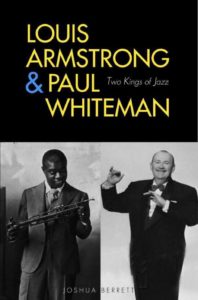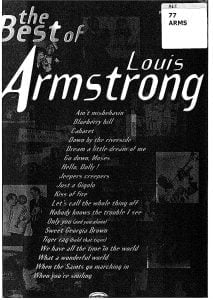Browse in the Library:
Or browse in the categories menus & download the Library Catalog PDF:
Louis Armstrong sings When You’re Smiling
Sheet Music Download.
When You’re Smiling (sheet music)
Louis Armstrong
(New Orleans, 1900 – New York, 1971) American jazz trumpeter, singer and bandleader. To define this artist, the words of Duke Ellington are especially appropriate, who said that if there was a real Mr. Jazz, it was undoubtedly Louis Armstrong.

His musical beginnings took place in his hometown, where he played with various groups until 1922, the year in which Joe King Oliver incorporated him into his Creole Jazz Band in Chicago, where he married the band’s pianist, Lilian Hardin. As a result of his performances in the capital of Illinois, Fletcher Henderson invited him to New York in 1924 to play in his big band, with which he recorded some records that highlighted the creativity and originality of the musician. His virtuosity in improvisation exerted a great influence on New York jazz musicians.

In 1925, he returned to Chicago and founded his own group, a quintet (The Hot Five) that later became a septet (The Hot Seven), with which he became one of the most renowned jazz musicians in the world and achieved that in the 1920s, Chicago shared the world capital of jazz with New York, a city to which he returned at the end of that same decade, among other reasons, to strengthen his film career.
He made his film debut with the appearance in the film Ex-flame (1930), the year in which he also separated from Lilian Hardin. In 1932 she made a successful tour of the United Kingdom, which he would repeat the following year, although this time he also included Denmark, Norway and Holland on his itinerary. In 1936, her popularity was such that she decided to publish an autobiography, which she titled Swing that music.
Seven years after their marital separation, she obtained a divorce and then married Alpha Smith. In 1939, she participated in the performance of Swingin’ the dream, a version of William Shakespeare’s A Midsummer Night’s Dream in the key of jazz. After four years of marriage, he divorced his second wife and married Lucille Wilson for a third time.
Best Sheet Music download from our Library.
Armstrong’s group, which had taken the form of a big band after his final move to New York in 1929, underwent a further transformation in 1947: he reduced its number of members to seven and changed its name to Louis Armstrong and the All Stars. With this septet he participated in the Nice Jazz Festival (France) held in 1948, which is considered the first in history. Six years later, he published a second autobiography, Satchmo: My Life in New Orleans. During the 1950s he gave concerts in much of the world and toured Africa, Australia and Japan.
Regardless of his musical side, Louis Armstrong was a man of deep political convictions, which led him, on the one hand, to publicly condemn racial segregation and cancel a tour of the Soviet Union as a protest against the ruling communist regime.
In 1964, the theme Hello, Dolly from Gene Kelly’s musical of the same name (starring Barbra Streisand and Walter Matthau) gave him his first number one on the national charts. The following year, the municipal authorities of his native New Orleans granted him the key to the city. In 1970, a tribute was paid to him within the framework of the prestigious Newport Jazz Festival, in which figures of the stature of the singer Mahalia Jackson, Dizzy Gillespie, Bobby Hackett or The Eureka Brass Band participated.
5 things you may not know about Louis Armstrong
1. A family of Jewish immigrants helped him buy his first horn.
Armstrong was born on August 4, 1901, in a poor section of New Orleans nicknamed ‘the battlefield.’ His father abandoned the family when Armstrong was a child, and his teenage mother was often forced to turn to prostitution to make ends meet. Young Louis spent much of his childhood in the care of his grandmother, but he to found a second home among the Karnofskys, a local Lithuanian Jewish family who hired him to do odd jobs in their street vending business.
The jazz musician would later write that the Karnofskys treated him like their own son, often giving him food and even lending him money to buy his first instrument, a five-dollar cornet (he wouldn’t start playing the trumpet until 1926). . As a token of his gratitude to his Jewish benefactors, Armstrong later wore a Star of David pendant around his neck.
2. Armstrong first received musical training during a stint in a juvenile detention center.
Armstrong spent his youth singing on the street for money, but did not receive any formal musical training until he was 11, when he was arrested for firing a gun in the street during a New Year’s Eve celebration. The crime earned him a stint in a detention center called the Colored Waif’s Home for Boys, and it was there that Armstrong claimed, ‘Me and the music got married.’
He spent his 18-month sentence learning to play the bugle and cornet from Waif’s Home music teacher Peter Davis, eventually becoming a star in his marching band. Armstrong continued to hone his skills in the New Orleans honkytonks after his release and, in 1919, landed a big gig with a river band led by musician Fate Marable. “I think all my success goes back to the time I got arrested for being a runaway kid,” he later wrote, “because then I had to stop running and start learning something. Above all, I started learning music.”
3. Su esposa lo ayudó a impulsar su carrera en solitario.
After leaving New Orleans in 1922, Armstrong spent three years playing in jazz ensembles in Chicago and Harlem. He was mostly content to be a journeyman musician, but his second wife, a pianist named Lil Hardin, believed he was too talented not to have his own band. In 1925, while Armstrong was performing in New York, Hardin went behind her back and signed a contract with Chicago’s Dreamland Café to make him a featured act. He even demanded to be announced as ‘The World’s Greatest Trumpeter’.
Louis Armstrong was hesitant at first, but it turned out to be the best move of his career. Just a few days after his return to Chicago, OKeh Records allowed him to make his first recordings under his own name. Between 1925 and 1928, he and his backing bands, Hot Five and Hot Seven, recorded several dozen records that introduced the world to his improvisational trumpet solos and trademark scat singing. OKeh’s recordings would later play a key role in establishing Armstrong as a legendary figure in jazz. Meanwhile, his marriage to Hardin proved less successful: the couple divorced in 1938.
4. His playing style took a heavy toll on his lips.
Thanks to a relentless touring schedule and his penchant for playing high C on the trumpet, Armstrong spent much of his career battling severe lip damage. He played so hard that he often split his lip completely, and he suffered from painful scar tissue that a fellow musician said made his lips ‘as hard as a piece of wood’.
Louis Armstrong treated his lip calluses with a special ointment or even removed them himself with a razor, but over the years, he began to have difficulty hitting his trademark high notes. The trumpeter was so hard on his ‘chops’, as he called them, that a certain type of lip condition is now commonly known as ‘Satchmo Syndrome’.
5. At age 62, Armstrong surpassed The Beatles at the top of the pop charts.
In late 1963, Armstrong and his All Stars recorded the title song for an upcoming musical called ‘Hello, Dolly!’ The trumpeter didn’t expect much from the tune, but when the show debuted on Broadway the following year, it became a huge hit. For May, ‘Hello, Dolly!’ it had rocketed to the top of the charts, displacing two songs by The Beatles, then at the height of their popularity. At 62, Armstrong became the oldest musician in US history to have a number one song.
Browse in the Library:
Or browse in the categories menus & download the Library Catalog PDF:
